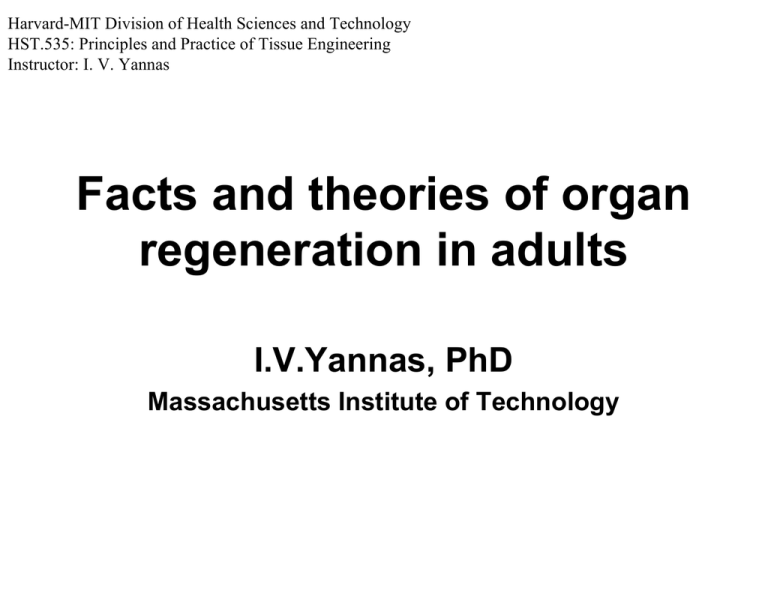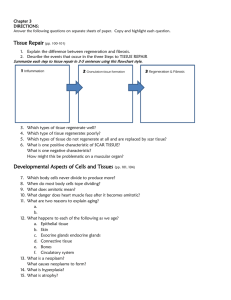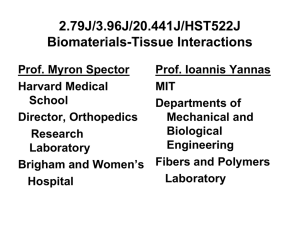Harvard-MIT Division of Health Sciences and Technology
advertisement

Harvard-MIT Division of Health Sciences and Technology HST.535: Principles and Practice of Tissue Engineering Instructor: I. V. Yannas Facts and theories of organ regeneration in adults I.V.Yannas, PhD Massachusetts Institute of Technology Outline A. Introduction: Synthesis of organs, in vitro or in vivo? B. Facts: Irreversible organ injury. C. Facts: Antagonistic relation between contraction and regeneration. D. Facts: Isomorphous replacement. E. Theories. 1. Immunocompetence theory. 2. Contraction blockade + isomorphous replacement. A. Introduction: Synthesis of organs, in vitro or in vivo? Skin: In vitro or in vivo synthesis? Figure by MIT OCW. Peripheral nerves: In vitro or in Figure by MIT OCW. In vitro or in vivo? Two published protocols, A and B, for synthesis of skin A. First step is In vitro: Keratinocytes + Fibroblasts + Collagen gel → Implant Second step is In vivo: Implant → Skin B. Directly In vivo: Keratinocytes + Dermis regeneration template → Skin Direct In vivo synthesis is simpler: • Investigator focuses on one reactor only. • Uses the endogenous cytokine field* and endogenous FB. No need to add growth factors, including angiogenesis factors. *Cytokine field: The unknown time- and space-dependent concentrations of growth factors and other cytokines in injured site. B. Irreversible organ injury. Why study the healing process? 1. In vitro or in vivo method → implant 2. Implant → injured anatomical site undergoing healing 3. Implant + healing → organ synthesis Two adult healing modes Spontaneous healing in adults injury → contraction + scar formation Healing by regeneration in adults injury → implant an active cell-seeded scaffold → MECHANISM? → organ synthesis Reversible injury in an amphibian Diagram removed for copyright reasons. See Figure 1.1 in Yannas, I. V. Tissue and Organ Regeneration in Adults. New York: Springer, 2001. ISBN: 0387952144. Spontaneous regeneration of amputated limb in the newt occurs independently of severity of injury Goss, 1992 Irreversible injury in adult mammal Photo removed for copyright reasons. Burn victim suffering from severe contraction and scar formation Tomasek et al., 2000 The tissue triad in skin and nerves epithelial tissue: 100% cellular, no ECM basement membrane: 100% ECM , no cells stroma: cells, ECM, blood vessels Figures by MIT OCW. Yannas, 2001 Skin: reversible injury Epidermis l ost. Dermis intact. Spontaneous regeneration Figure by MIT OCW. The epidermis is a regenerative tissue. After excision, it regenerates spontaneously. Reversible injury. No contraction. No scar. Yannas, 2001 Skin: Irreversible injury Scar spontaneous healing of fullthickness skin excision by contraction and scar formation Epidermis and dermis both Closure by contraction . lost to severe injury and scar formation Figure by MIT OCW. The dermis is a nonregenerative tissue in the adult. After excision, it does not regenerate spontaneously. Irreversible injury. Closes with contraction and scar formation. Yannas, 2001 Peripheral nerve: reversible injury Injured myelin. Endoneurium intact. Axoplasm Myelin sheath crushed nerve heals spontaneously by regeneration Regenerated myelin Figure by MIT OCW. The myelin sheath is a regenerative tissue. Following nerve crushing with myelin disruption, the myelin regenerates spontaneously. Reversible injury. No contraction. No scar. Yannas, 2001 Peripheral nerve: irreversible injury Transected nerve. Both myelin and endoneurium are severely injured. Neuroma forms at each stump by contraction and scar formation. Figure by MIT OCW. The endoneurial stroma is a nonregenerative tissue. Following transection, it forms neural scar (neuroma). Irreversible injury. Closes with contraction and scar formation. Yannas, 2001 Summary: Increased severity of injury −−−−−−→ Regenerative tissues. Nonregenerative Reversible injury. No tissues. Irreversible injury. contraction. Contraction+scar. SKIN epidermis dermis (stroma) BM NERVE myelin BM endoneurial stroma C. Facts: Antagonistic relation between contraction and regeneration. • • Methodology: defect closure rule. Four sets of data showing changes in importance of healing modes (C, S, R) with : I. II. III. IV. Development. Severity of organ injury. Scaffold-induced regeneration in adults. Impairment of healing. Quantitative description of healing processes: The defect closure rule. Separate mechanism from final state! • The initial state is the freshly injured wound. Wound area is Ao. • The final state is the closed wound. Ao eventually has closed up by three processes: contraction, scar formation, regeneration. No other processes involved in wound closure. • Closure of wound by contributions from contraction (%C), scar formation (%S) or regeneration (%R). Defect closure rule: C + S + R = 100 Measurement of C, S and R in full-thickness skin wounds after wound has closed. Use only “final state” data! C S reviewed in Yannas, 2001 Representative data illustrating the defect closure rule Spontaneously healing defect general case Configuration of final state [C, S, R] Ideal fetal healing [0, 0, 100] Dermis-free skin/ adult rodents Dermis-free skin/ adult human Peripheral nerve/ adult rat [96, 4, 0] [96, 4, 0] Conjunctiva/ adult rabbit [45, 55, 0] [37, 63, 0] Data reviewed in Yannas, 2001 Data set 1: Change in healing modes (C, S, R) with development • During the fetal-to-adult transition in mammals contraction gradually replaces regeneration as the major mode of wound closure (Lorenz et al., 1992; Mast et al., 1992; Stocum, 1995; McCallion and Ferguson, 1996; Martin, 1997). • During amphibian development contraction becomes dominant and scar appears as regeneration recedes (Stocum, 1995; Tsonis, 1996; Yannas et al., 1996). Tadpole development → Frog Developmental changes in configuration of final state [C, S, R]: Development −−−−−−−−−−−−−−−−−−−−→ [41, 0, 59] → [62, 0, 38] → [66, 0, 34] → [90, 10, 0] tadpole → frog Yannas et al., 1996 Data set 2: Scaffold-induced regeneration in adults a. Regeneration is induced when a scaffold blocks contraction. Three organs: Skin, conjunctiva, peripheral nerve. b. Scar is abolished when contraction is blocked by a scaffold, even modestly. Comment: At least in rodents, scar formation appears to be a process secondary to contraction. Data illustrating use of active scaffolds in 3 organs Organ/ Treatment species used Skin/guinea pig scaffold DRT Spontaneous healing [91, 9, 0] Treated with template Skin/guinea pig scaffold DRT+ KC [92, 8, 0] [28, 0, 72] Conjunctiva/ rabbit Nerve/rat scaffold DRT [45, 55, 0] [13, 0, 87] silicone tube+scaffold NRT collagen tube+scaffold NRT [95, 5, 0] [53, 0, 47] [95, 5, 0] [0, 0, 100] Nerve/rat [89, 0, 11] Data reviewed in Yannas, 2001 Kinetics of closure of skin defect area using three protocols KC = keratinocytes DRT = dermis regeneration template (active scaffold) Graph of % initial defect area vs. time - removed for copyright reasons. adapted from Yannas et al., 1989 Myofibroblast detected with antibody to α-SM actin Diagram removed for copyright reasons. Tomasek et al., 2000 Contraction blocked by scaffold (bottom) Ungrafted. Contracting vigorously. → Photo removed for copyright reasons. Red-brown: stained with antibody to α-SM actin. 10 d Grafted with DRT. No contraction. Photo removed for copyright reasons. → Troxel, 1994 Mechanism of contraction inhibition by DRT scaffold in skin wound 1. Fact: Reduction in number of myofibroblasts. 2. Fact: Disruption of myofibroblast organization. Injured conjunctiva model (excise full-thickness conjunctiva including entire stroma, then graft with scaffold) DRT = dermis regeneration template in proximal layer (grafted on wound) Eyelid Fornix Sclera ↑ surgery Cornea Scaffold DRT Sutures Figure by MIT OCW. Low mag (eyeball) High mag (grafted conjunctiva) DRT graft blocked contraction of conjunctival wound % Fornix Shortening 30 ungrafted 15 grafted with scaffold DRT Graph by MIT OCW. 0 0 15 30 Days Hsu et al., 2000 Data set 3. Impaired healing of skin wounds Dermis-free wounds in: • genetically diabetic mouse • genetically obese mouse • infected wounds • mechanically splinted • treated with steroids all impaired-healing wounds showed strong delay in contraction but did not show regeneration Data from: Lindquist, 1946; Billingham and Russell, 1952; Cuthbertson, 1959; Abercrombie et al., 1960; Zahir, 1964; Stone and Madden, 1975; Kennedy and Cliff, 1979; McGrath, 1982; Klingbeil et al., 1991; Greenhalgh et al., 1990; Fiddes et al., 1991; Hayward et al., 1992. Summary of Data Sets 1-3. 1. During amphibian larval (tadpole) development; also, during the fetal-to-adult transition in mammals: C↑ R↓ 2. Certain scaffolds block contraction and induce partial regeneration in adult mammals (rodents, swine, human). C↓ R↑ Also scar is abolished when contraction is blocked, even partly. C↓ S = 0 3. Impaired healing blocks contraction but does not induce regeneration. C = 0 R = 0 How does an active scaffold block contraction? Identify structural determinants of scaffold activity. Critical structural features of biologically ECM analogs used as scaffolds 1. chemical composition (ligand identity) 2. pore structure (ligand density) 4. macromolecular structure (scaffold duration) Diagram removed for copyright reasons. 3. orientation of pore channels (ligand spatial coordinates) The graphic shows many scaffolds but dermis regeneration template (DRT) is the active scaffold (template). Ligand density is optimal between 20 and 120 µm, Graph removed for copyright reasons. Yannas et al., 1989 Structural determinants of regeneration template activity Structural parameter of scaffold Scaffold induces SKIN regeneration* Scaffold Contribution to induces NERVE regenerative regeneration** activity Type I collagen/GAG, w/w 98/2 98/2 Ligand identity → Myofibroblasts (MFB) bound on scaffold Average pore diameter, µm 20-120 5-10 Ligand density → Almost all MFB bound on scaffold Pore channel orientation random axial Spatial coordinates of ligands → Morphology of new organ Average molecular weight between crosslinks****, Mc, kDa 5-15 40-60 Duration of scaffold topology → Synchronization with synthetic process Degree of residual collagen fiber crystallinity (residual banding)*** ca. 5% of native collagen ca. 5% of native collagen Inhibition of plateletaggregation → Reduce number of myofibroblasts D. Facts: Isomorphous replacement Must explain not only contraction blocking but also synthesis of organ Rules of Organ Synthesis Rule 1. Isomorphous Replacement Stroma regeneration proceeds on the surface of a matrix that is a replica of the native stroma of the organ. Rule 2. Synchronous Tissue Synthesis The template is required to remain intact (undegraded) long enough to initiate synthesis of new stroma but not long enough to block sterically the synthesis of new tissues. Summary of stroma synthesis. A scaffold cannot induce organ synthesis unless it is a configurational replica of the desired stroma and unless it degrades at a rate equal to the rate of stroma synthesis at the injured anatomical site. E. Theories of regeneration. 1. Contraction blocking and isomorphous replacement. 2. Immunocompetence theory. Contraction blockade theory explains Data Sets 1-3 symbols refer to [C, S, R] • Inhibition of contraction is necessary but does not suffice to induce organ regeneration in adults ∆R > 0 and S → 0 if ∆C < 0 Explain facts of regeneration using unified theory: Contraction blockade + + Isomorphous replacement → → Regeneration Alternative theories of induced organ regeneration in adults 1. Increase in immune competence during development controls the gradual loss of regenerative potential that accompanies metamorphosis in amphibians and the fetal-adult healing transition in adults (Heber-Katz, 1999; Harty et al., 2003). 2. Regeneration is induced in adults by a scaffold that blocks contraction and provides a topology similar to the stroma being regenerated, remaining intact only for the duration of organ synthesis (Yannas, 2001). Two theories of transition in healing response 1. Fetal → immune competence development → Adult 2. Adult → template → Fetal





